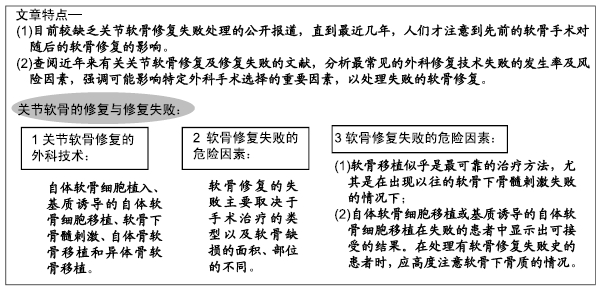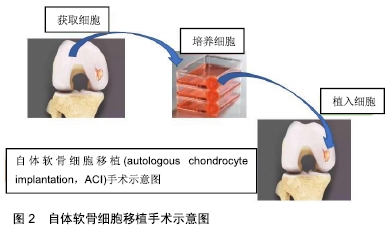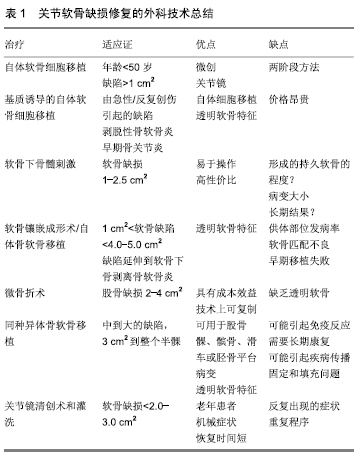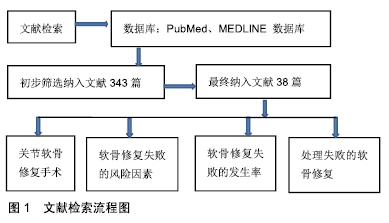[1] SCHINHAN M, GRUBER M, DOROTKA R, et al. Matrix-associated autologous chondrocyte transplantation in a compartmentalized early stage of osteoarthritis. Osteoarthritis Cartilage. 2013;21(1):217-225.
[2] MAKRIS EA, GOMOLL AH, MALIZOS KN, et al. Repair and tissue engineering techniques for articular cartilage.Nat Rev Rheumatol.2015;11:21-34.
[3] ROSA D, DI DONATO SL, BALATO G, et al. How to manage a failed cartilage repair: a systematic literature review. Joints. 2017;5(2):93-106.
[4] HUEY DJ, HU JC, ATHANASIOU KA. Unlike bone, cartilage regeneration remains elusive. Science. 2012;338(6109): 917-921.
[5] LAMPLOT JD, SCHAFER KA, MATAVA MJ. Treatment of Failed Articular Cartilage Reconstructive Procedures of the Knee: A Systematic Review. Orthop J Sports Med.2018; 6(3):2325967118761871.
[6] BROUWER RW, HUIZINGA MR, DUIVENVOORDEN T, et al. Osteotomy for treating knee osteoarthritis. Cochrane Database Syst Rev 2014;(12):CD004019.
[7] GRACITELLI GC, MERIC G, BRIGGS DT, et al. Fresh osteochondral allografts in the knee: comparison of primary transplantation versus transplantation after failure of previous subchondral marrow stimulation. Am J Sports Med. 2015;43(4):885-891.
[8] BIANT LC, MCNICHOLAS MJ, SPROWSON AP, et al.The surgical management of symptomatic articular cartilage defects of the knee: consensus statements from United Kingdom knee surgeons. Knee 2015;22(05):446-449.
[9] DEVITT BM, BELL SW, WEBSTER KE, et al. Surgical treatments of cartilage defects of the knee: Systematic review of randomised controlled trials. Knee.2017;24: 508-517.
[10] STEADMAN JR, BRIGGS KK, MATHENY LM, et al. Outcomes following microfracture of full-thickness articular cartilage lesions of the knee in adolescent patients.J Knee Surg 2015;28(02):145-150.
[11] SALZMANN GM, SAH B, SÜDKAMP NP, et al. Reoperative characteristics after microfracture of knee cartilage lesions in 454 patients. Knee Surg Sports Traumatol Arthrosc.2013; 21(2):365-371.
[12] SOLHEIM E, ØYEN J, HEGNA J, et al. Microfracture treatment of single or multiple articular cartilage defects of the knee: a 5-year median follow-up of 110 patients.Knee Surg Sports Traumatol Arthrosc.2010;18(4):504-508.
[13] BENTLEY G, BIANT LC, VIJAYAN S, et al., Carrington RW. Minimum ten-year results of a prospective randomised study of autologous chondrocyte implantation versus mosaicplasty for symptomatic articular cartilage lesions of the knee. J Bone Joint Surg Br.2012;94(4):504-509.
[14] ROBB CA, EL SAYED C, MATHARU GS, et al. Survival of autologous osteochondral grafts in the knee and factors influencing outcome. Acta Orthop Belg. 2012;78(05): 643-651.
[15] MINAS T, VON KEUDELL A, BRYANT T, et al.. The John Insall Award:a minimum 10-year outcome study of autologous chondrocyte implantation. Clin Orthop Relat Res.2014;472(01):41-51.
[16] GOMOLL AH, GILLOGLY SD, COLE BJ, et al. Autologous chondrocyte implantation in the patella: a multicenter experience. Am J Sports Med.2014;42(5):1074-1081.
[17] FARR J. Autologous chondrocyte implantation improves patellofemoral cartilage treatment outcomes. Clin Orthop Relat Res.2007;463:187-194.
[18] LEVY YD, GÖRTZ S, PULIDO PA, et al. Do fresh osteochondral allografts successfully treat femoral condyle lesions? Clin Orthop Relat Res.2013;471(1):231-237.
[19] GRACITELLI GC, MERIC G, PULIDO PA, et al, Bugbee WD. Fresh osteochondral allograft transplantation for isolated patellar cartilage injury. Am J Sports Med.2015;43(4): 879-884
[20] SADR KN, PULIDO PA, MCCAULEY JC, et al. Osteochondral allograft trans-plantation in patients with osteochondritis dissecans of the knee. Am J Sports Med.2016;44(11):2870-2875.
[21] DEGEN RM, COLEMAN NW, CHANG B, et al, Williams RJ. Outcomes following structural grafting of distal femoral osteochondral injuries in patients aged 40 years and older. J Knee Surg. 2017;30(3):244-251
[22] BERRUTO M, DELCOGLIANO M, DE CARO F, et al. Treatment of large knee osteochondral lesions with a biomimetic scaffold: results of a multicenter study of 49 patients at 2-year follow-up. Am J Sports Med.2014;42(7): 1607-1617.
[23] DHOLLANDER AA, LIEKENS K, ALMQVIST KF, et al. A pilot study of the use of an osteochondral scaffold plug for cartilage repair in the knee and how to deal with early clinical failures. Arthroscopy. 2012;28(02):225-233.
[24] HORTON MT, PULIDO PA, MCCAULEY JC, et al. Revision osteochondral allograft transplantations: do they work? Am J SportsMed.2013;41(11):2507-2511
[25] GRACITELLI GC, MERIC G, BRIGGS DT, et al. Fresh osteochondral allografts in the knee: comparison of primary transplantation versus transplantation after failure of previous subchondral marrow stimulation. Am J Sports Med.2015;43(4):885-891
[26] GRACITELLI GC, MERIC G, PULIDO PA, et al. Osteochondral allograft transplantation for knee lesions after failure of cartilage repair surgery.Cartilage.2015; 6(2): 98-105
[27] JUNGMANN PM, SALZMANN GM, SCHMAL H, et al. Autologous chondrocyte implantation for treatment of cartilage defects of the knee: what predicts the need for reintervention? Am J Sports Med. 2012;40(1):58-67.
[28] NIETHAMMER TR, VALENTIN S, FICKLSCHERER A, et al. Revision surgery after third generation autologous chondrocyte implantation in the knee. Int Orthop.2015; 39(8):1615-1622.
[29] VIJAYAN S, BENTLEY G, RAHMAN J, et al. Revision cartilage cell transplantation for failed autologous chondrocyte transplantation in chronic osteochondral defects of the knee. Bone Joint J. 2014;96-B(1):54-58.
[30] BERIS AE, LYKISSAS MG, KOSTAS-AGNANTIS I, et al. Treatment of full-thickness chondral defects of the knee with autologous chondrocyte implantation: a functional evaluation with long-term follow-up. Am J Sports Med. 2012;40(3):562-567.
[31] ROSA D, BALATO G, CIARAMELLA G, et al.Long-term clinical results and MRI changes after autologous chondrocyte implantation in the knee of young and active middle aged patients. J Orthop Traumatol.2016;17(1): 55-62.
[32] MURPHY RT, PENNOCK AT, BUGBEE WD. Osteochondral allograft transplantation of the knee in the pediatric and adolescent population. Am J Sports Med.2014;42(3): 635-640.
[33] FRANK RM, LEE S, LEVY D, et al. Osteochondral allograft transplantation of the knee: analysis of failures at 5 years. Am J Sports Med.2017;45(4):864-874.
[34] JOSHI N, REVERTE-VINAIXA M, DÍAZ-FERREIRO EW, et al. Synthetic resorbable scaffolds for the treatment of isolated patellofemoral cartilage defects in young patients: magnetic resonance imaging and clinical evaluation. Am J Sports Med.2012;40(6):1289-1295.
[35] BRIGGS DT, SADR KN, PULIDO PA, et al.. The use of osteochondral allograft transplantation for primary treatment of cartilage lesions in the knee. Cartilage.2015; 6(4):203-207.
[36] BERT JM. Abandoning microfracture of the knee: has the time come? Arthroscopy. 2015;31(3):501-505.
[37] ZEDDE P, CUDONI S, GIACHETTI G, et al. Subchondral bone remodeling: comparing nanofracture with microfracture. an ovine in vivo study. Joints.2016;4(2): 87-93.
[38] BENTLEY G, BHAMRA JS, GIKAS PD, et al. Repair of osteochondral defects in joints--how to achieve success. Injury. 2013;44 Suppl 1:S3-10.
|




